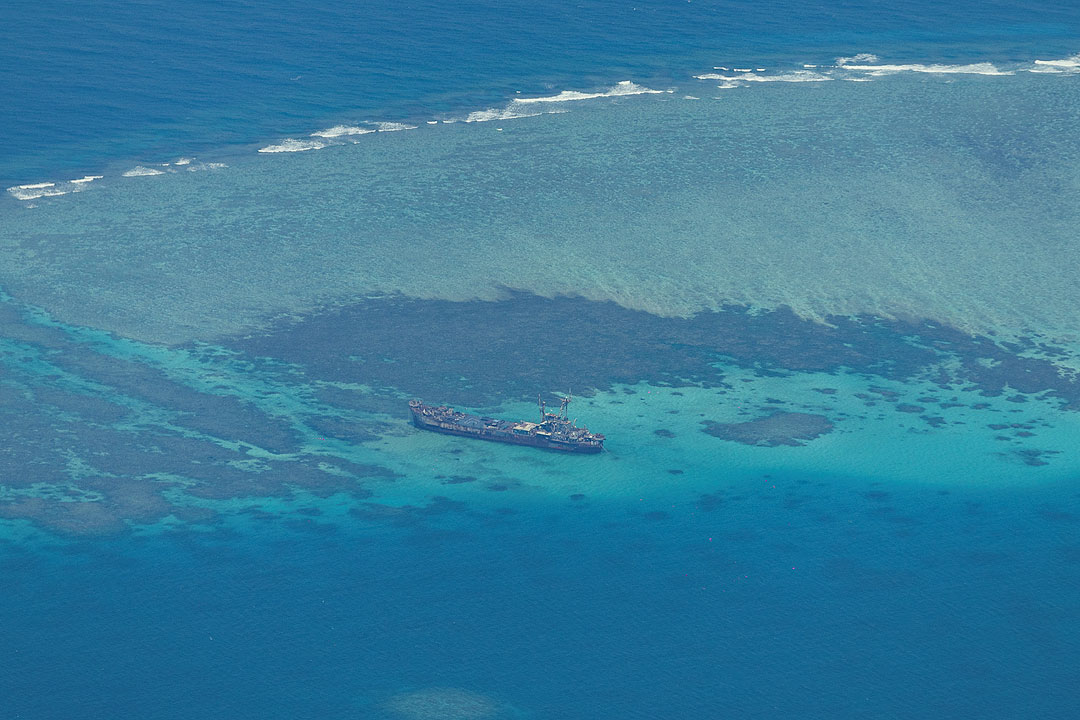Philippines eyes permanent structure at shoal

By Kyle Aristophere T. Atienza, Reporter
THE PHILIPPINES may replace a dilapidated ship that it grounded at Second Thomas Shoal (Ayungin Shoal) in 1999 with a permanent structure, its military said, amid increasing tensions with China.
President Ferdinand R. Marcos, Jr. wants the military to ensure that the grounded BRP Sierra Madre remains “strong enough to be able to fly the Philippine flag until a permanent structure is erected there,” Armed Forces of the Philippines Western Command chief Alberto Carlos told reporters on the sidelines of a security forum in Manila on Wednesday. “We intend to comply with that order.”
Senators are deliberating on the proposed P5.786-trillion national budget for next year, and some of them are pushing to boost the budgets of the Philippine Coast Guard and other security agencies. The House of Representatives passed its version of the budget bill on final reading on Wednesday night.
“We are happy with the news that came out recently as far as the funding for the permanent structure at Ayungin Shoal [is concerned],” Mr. Carlos said, referring to Second Thomas Shoal. “Initially there was a P100-million budget for a permanent structure, and now they increased it to P600 million. And they call it a ranger station.”
Tensions between the Philippines and China have worsened in recent weeks after the latter’s coast guard fired water cannons at Philippine vessels trying to deliver food and other supplies to BRP Sierra Madre on Aug. 5.
The Philippines intentionally grounded the World War II-era ship there in 1999 to assert its claim and after China seized Mischief Reef in 1995. China has created a large artificial island on the atoll, which is 250 kilometers west of the Philippine island of Palawan, including a 2,700-meter runway and associated airfield.
China’s coast guard and maritime militia vessels have continued to conduct “dangerous maneuvers” against Philippine resupply vessels after the incident.
“We will have to reclaim and transform the area into a dry Island that can withstand waves and storms,” Joshua Bernard B. Espeña, a resident fellow at the Manila-based think tank International Development and Security Cooperation, said in a Facebook Messenger chat. “Manila has to brace for the possibility of more dangerous maneuvers and targeting from China’s maritime forces.”
The Philippines would also need faster naval and coast guard ships “to conduct complementary force protection.”
Earlier this month, the town of Quezon in Palawan province passed a resolution urging all municipalities in the province to allocate P500,000 for the refurbishment of the rusting military outpost.
Mr. Espeña said once a permanent structure, particularly a man-made island, is established, it must be protected with medium-range missiles, air defense systems and early warning systems.
“A permanent base would also have to be optimized towards achieving sea control and anti-access/area denial,” he said. “As much as we want to civilianize this place, this is too dangerous given how contested this place is, especially if we are not intentional in weakening the Chinese position.”
‘EFFECTIVE OCCUPATION’
Mr. Espeña proposed to make the structure hybrid — “a military base and a thriving hub for marine science research.” “This increases the costs imposed on Beijing.”
Blake Herzinger, a research fellow at the foreign policy and defense program of the United States Studies Center, earlier said that the permanent structure should be manned by “combined rotational forces from both the Philippines and US Marine Corps” to deter Chinese efforts to block Philippine resupply missions.
BRP Sierra Madre, named by the US as USS Harnett County during World War II, was donated to the Philippines in 1976.
China last month said the Philippine government had pledged to remove the grounded ship from the shoal, which is about 200 kilometers from the Philippine island of Palawan and more than 1,000 kilometers from China’s nearest major landmass, Hainan Island.
Mr. Marcos has said he’s “not aware of any such arrangement or agreement.” If there exists such an agreement, “I rescind that agreement now.”
Experts have said China has tried to advance its claims in the South China Sea through psychological warfare or disinformation.
At the security forum, Mr. Carlos said they are seeking to boost Philippine presence in the South China Sea through the “effective occupation of the islands that we already occupied” and a stronger naval presence.
The country also seeks to enhance maritime domain awareness, which would allow it to “know what is happening in our area, precisely where they are, where are all the vessels of interest, the militia vessels, the Chinese Coast Guard.”
Mr. Carlos, during the briefing with reporters, said they expect a shift in the allocation of resources and forces to address external security threats.
“It’s a normal tweaking of strategy, normal tweaking of the course of action that you will take considering the situation on the ground,” he added. “We are happy with the initial signs that we are saying. We see ships being deployed in the West Philippine Sea from other areas. It’s a work in progress.”
China claims more than 80% of the South China Sea based on a 1940s map that a United Nations-backed tribunal in The Hague voided in 2016.
The Philippines recently removed a floating barrier that the Chinese Coast Guard had installed at Scarborough Shoal (Bajo de Masinloc).
Philippine authorities have said the barrier denied Filipino fishermen access to the traditional fishing ground over which Manila, Vietnam, and Beijing have fishing rights. The shoal falls within the Philippines’ exclusive economic zone.
The Philippine Coast Guard earlier this month reported the destruction of coral reefs at Iroquois Reef and Sabina Shoal, which were surrounded by Chinese maritime militia vessels.



